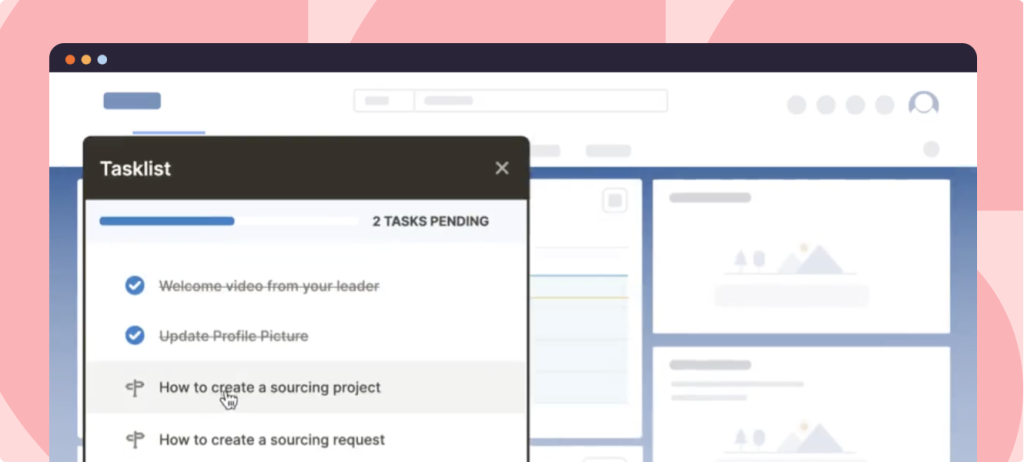Training gaps prevent you from empowering your employees with the upskilling they need to support your organization’s learning goals. You need to address those to increase competency within your organization and bridge performance gaps.
You can’t eliminate them once and for all — new skills gaps will continue to appear as your business grows, but you can establish a process for identifying those training gaps before they become roadblocks.
In this guide, we offer a consistent strategy for uncovering and addressing employee training gaps in your organization.
What Are Training Gaps?
Training gaps are areas where employees lack the knowledge or skills to achieve certain work goals. Identifying and addressing these gaps helps organizations ensure that their workforce has the necessary capabilities to perform effectively and contribute to the company’s overall success.
Training gaps may arise as a result of implementing new technology, evolving business requirements, or just insufficient training. There’s nothing wrong with having training gaps in your team or organization. Identifying those gaps helps you develop a training strategy to develop the lacking skills or knowledge and build a more successful team.
How to Analyze and Identify Training Gaps In Your Workplace
The process of identifying skills gaps is called a training needs assessment. Here’s how you perform it.
1. Set learning objectives and outcomes
Before you begin, think of what makes you run this analysis. What goals are you trying to achieve by offering your employees relevant training?
Understanding the purpose will provide focus and direction to your analysis.
Clearly define the reasons for conducting the training needs assessment. For instance, you may want to identify the reasons behind poor employee performance, address specific organizational challenges, or adopt new business software.
2. Determine the skills or knowledge you need
What knowledge, skills, or competencies does your team or organization need to achieve the goal you’ve just specified?
Create a competency model that lists all the soft and hard skills it will take to perform the task successfully. Determine desired proficiency levels for each skill — this will be a benchmark you’ll be comparing your employees’ skill sets against.
Follow these tips to benchmark the proficiency levels:
- Categorize the skills based on their relevance to the goal. For example, if you’re aiming to enhance customer service, you may identify categories such as communication skills, problem-solving skills, and product knowledge and make them focal points within your customer service training.
- Consider the skills that are crucial for successful job performance and prioritize them accordingly.
- Define the desired proficiency levels for each skill category. You can do it by using descriptive labels that indicate different levels of proficiency, such as beginner, intermediate, advanced, or using a numerical scale from 1 to 10.
3. Communicate the purpose of assessments to employees
To make sure your employees aren’t enticed to overestimate their skills during the assessment process, make it clear why you’re performing this evaluation.
Clearly convey that the assessment is not designed to “weed out” or negatively evaluate their performance. Instead, highlight that the purpose is to identify employee development areas where additional support and training can be provided.
4. Break down skills based on jobs and teams
You should align the assessment process with specific job roles and team responsibilities, ensuring that the skills being assessed are relevant and tailored to each group.
If you’re running an organization-wide assessment process, you’ll most likely need different skill proficiency levels from different roles. Within each job role or team, prioritize the required skills based on their importance and relevance to the job responsibilities.
Outline the specific expectations and criteria for each proficiency level. For example, if the skill is “customer service,” you would determine what it means to be at a basic level, an intermediate level, or an advanced level in customer service.
5. Create a proficiency scoring system
Determine the rating scale that you will use to assess and score employees’ skills. This could be a numerical scale (e.g., 1 to 10) or descriptive labels (e.g., Novice, Beginner, Intermediate, Advanced).
For each proficiency level, establish clear criteria that define what it means to achieve that level of proficiency. Refer back to the expectations and criteria outlined in the previous step.
6. Assess employee skills
It’s time to assess the current skill levels of your employees. You’ll need to combine the data from a range of assessments to create a reliable data set:
- Collect employee feedback. Use surveys and questionnaires to collect insights into employees’ self-perception of their skills and knowledge.
- Run assessment tests. Develop tests or quizzes that evaluate employees’ understanding and proficiency in specific areas.
- Offer practical assessments. Design tasks or simulations that allow employees to showcase their abilities in a real or simulated work environment.
- Conduct 360-degree reviews. Gather feedback from people an employee interacts with.
Analyze individual assessments to understand each employee’s strengths and areas for improvement. Consolidate the data on all the skills and knowledge your employees have, making notes on the current proficiency levels and the number of employees that have specific capabilities.
Related Resources
7. Plot your data in a skills matrix
A skills matrix visually represents the proficiency levels of employees in different skills or competencies, allowing you to identify skill gaps and prioritize training needs. Here’s how you build and analyze it:
- List the skills you’re looking for in your organization (see step 2) on one axis and the employees’ names or identifiers on the other axis.
- Fill in the skill matrix with the proficiency levels obtained from the assessments conducted in step 6.
- Identify areas where there are significant gaps between the desired proficiency levels (benchmark) and the actual proficiency levels of your employees.

By plotting the data in a skill matrix, you can visualize the distribution of skills within your team or organization. Based on the proficiency level benchmarks, identify specific areas that require attention.
Get a customizable copy of our Skill Will Matrix template now!
✓ Thank you, the checklist will be sent to your email
8. Prioritize training needs
You’ve most likely identified more than one skill gap — shat should you do now?
You should determine which areas require immediate attention and focus based on their impact on business goals, employee performance, and organizational priorities.
This is a simple framework for prioritizing your training needs:
- Evaluate the significance of each skill gap in relation to your goal. Some skill gaps will have a more significant impact on performance, productivity, or the ability to achieve desired outcomes than others.
- Group related skills. Identify common themes or areas where multiple employees show proficiency gaps.
- Consider both immediate and long-term training needs. Some skills may require urgent attention due to their impact on ongoing projects or immediate business demands, while others may be more strategic in nature, contributing to long-term organizational growth.
- Evaluate the availability of resources, including budget, time, and expertise, to support training initiatives. Prioritize the training needs that you can address with the available resources.
- Compile a list of the prioritized training needs, ranking them in order of importance or urgency.
How to Address and Overcome Training Gaps
Once you’ve identified training gaps, you can design targeted training initiatives, such as workshops, courses, on-the-job training, or mentoring programs, to address the specific areas of need. We have three tips for you to successfully fill training gaps while minimizing process disruption.
1. Develop a training plan
You already know what skills you want employees to acquire or improve — go on and create a detailed training plan. There are a few considerations for you at this stage:
- Training methods. Select the most effective employee training methods based on the nature of the skills gaps and the learning preferences of your employees.
- Delivery schedule. Create a schedule that outlines the timing and duration of each training activity. Will training take place during work time, or are you going to offer compensation for training outside working hours?
- Budget. Consider both direct and indirect training costs when allocating your budget.
- Existing initiatives. Take into account any existing training initiatives or programs that are already in place within your organization. Assess how these initiatives align with the identified training gaps and determine if any adjustments or enhancements need to be made to integrate them into your overall training plan. For instance, you could update your onboarding flows with relevant training to equip your new hires with the necessary skills from their first days at work.
- Evaluation methods. Determine how you will assess the effectiveness of the training. This could involve pre- and post-training assessments, participant feedback surveys, on-the-job performance evaluations, or other evaluation methods.
2. Use employee training software
Regardless of the selected training method(s), the right software will help you effectively deliver training and facilitate progress tracking.
There are various types of training software that can support your training initiatives and enhance the learning experience for your employees. You can choose the right one based on your needs:
- Learning Management System (LMS): Enterprise LMS is a type of software allows you to create, deliver, and track training courses and materials. TalentLMS and iSpring provide features such as course management, content authoring, progress tracking, assessments, and reporting.
- Digital Adoption Platform (DAP): DAPs like like Whatfix offer seamless software training through in-app guided content such as interactive walkthroughs, onboarding flows, and knowledge bases. This type of training content is delivered directly inside software applications, no coding required.
- Knowledge Management System: this is where all the company knowledge and documentation is stored. Employees can use it to access the necessary information exactly when they need it. Notion and ClickUp offer decent freemium packages for those looking to organize their company knowledge.
- Microlearning Software: Microlearning platforms let organizations split their training programs into bite-sized pieces, allowing employees to spend less time and effort consuming training content. iSping is an example of an LMS with microlearning capabilities.


→ Guide users through complex apps with contextual, role-based in-app guidance.
→ Support users at the moment of need with AI-powered Self Help and embedded workflow assistance.
→ Analyze user engagement to identify friction points and optimize business processes.
3. Monitor and evaluate training effectiveness
You’ve mapped out your training program and launched it with the help of relevant software — what’s next?
To ensure that your training initiatives are effective in addressing the identified gaps, continue to monitor and evaluate their impact.
Use your employee training software for data analytics. Your selected system(s) should allow you to track progress, analyze training outcomes, and make data-driven decisions for future training initiatives.
Whatfix offers detailed guidance analytics, providing you with insights into how users interact with your business tools and in-app training content.
Conduct pre-training and post-training assessments to measure the extent to which employees have acquired the targeted knowledge and skills. Monitor the application of newly acquired skills and knowledge in the workplace.
Collect employee feedback on their training experience. Those insights will help you better understand what stands behind the metrics you’re monitoring.
Training Clicks Better With Whatfix
Seventy-eight percent of software users lack the expertise of the tools they use daily. Software training should be your top priority when closing skill gaps in your organization.
In the era of digital transformation, technology is present in nearly every business operation, and your primary responsibility is to enable your employees to use it effectively. Whatfix will help you bridge your tech skills gap.
Sign up for a free trial and access the following:
- Interactive in-app guidance: With step-by-step walkthroughs, tooltips, and contextual help, employees can quickly learn and apply new skills directly within their workflow, reducing the learning curve and increasing productivity.
- Self-help: The Whatfix platform offers an on-demand help widget to employees, allowing them to access relevant training materials whenever they need assistance.
- Personalized training experience: Whatfix allows you to create customized training content based on the specific needs of your workforce. Tailor training materials to different roles, departments, or skill levels, ensuring that employees receive targeted and relevant training to address their specific skill gaps.
- Whatfix Analytics: With Whatfix’s detailed guidance analytics, you gain valuable insights into employee training progress, content engagement, and user behavior.






